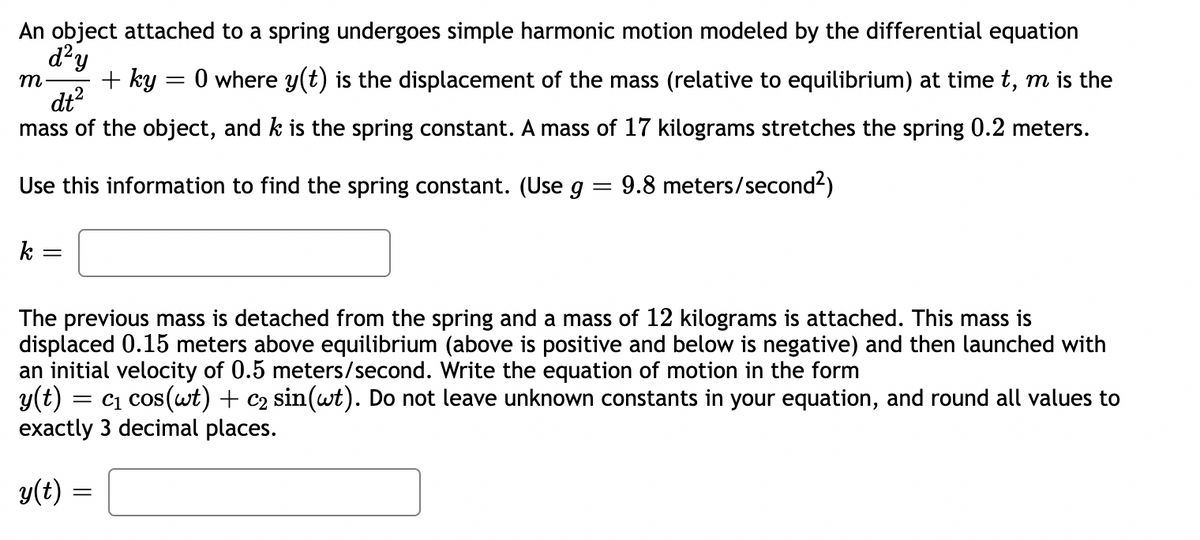An object attached to a spring undergoes simple harmonic motion modeled by the differential equation d?y + ky = 0 where y(t) is the displacement of the mass (relative to equilibrium) at time t, m is the m dt? mass of the object, and k is the spring constant. A mass of 17 kilograms stretches the spring 0.2 meters. Use this information to find the spring constant. (Use g = 9.8 meters/second²) k = The previous mass is detached from the spring and a mass of 12 kilograms is attached. This mass is displaced 0.15 meters above equilibrium (above is positive and below is negative) and then launched with an initial velocity of 0.5 meters/second. Write the equation of motion in the form y(t) = c1 cos(wt) + c2 sin(wt). Do not leave unknown constants in your equation, and round all values to exactly 3 decimal places. y(t) =
An object attached to a spring undergoes simple harmonic motion modeled by the differential equation d?y + ky = 0 where y(t) is the displacement of the mass (relative to equilibrium) at time t, m is the m dt? mass of the object, and k is the spring constant. A mass of 17 kilograms stretches the spring 0.2 meters. Use this information to find the spring constant. (Use g = 9.8 meters/second²) k = The previous mass is detached from the spring and a mass of 12 kilograms is attached. This mass is displaced 0.15 meters above equilibrium (above is positive and below is negative) and then launched with an initial velocity of 0.5 meters/second. Write the equation of motion in the form y(t) = c1 cos(wt) + c2 sin(wt). Do not leave unknown constants in your equation, and round all values to exactly 3 decimal places. y(t) =
Advanced Engineering Mathematics
10th Edition
ISBN:9780470458365
Author:Erwin Kreyszig
Publisher:Erwin Kreyszig
Chapter2: Second-order Linear Odes
Section: Chapter Questions
Problem 1RQ
Related questions
Question

Transcribed Image Text:An object attached to a spring undergoes simple harmonic motion modeled by the differential equation
d?y
+ ky
dt?
mass of the object, and k is the spring constant. A mass of 17 kilograms stretches the spring 0.2 meters.
0 where y(t) is the displacement of the mass (relative to equilibrium) at time t, m is the
m
Use this information to find the spring constant. (Use g = 9.8 meters/second?)
k =
The previous mass is detached from the spring and a mass of 12 kilograms is attached. This mass is
displaced 0.15 meters above equilibrium (above is positive and below is negative) and then launched with
an initial velocity of 0.5 meters/second. Write the equation of motion in the form
y(t) = c1 cos(wt) + c2 sin(wt). Do not leave unknown constants in your equation, and round all values to
exactly 3 decimal places.
y(t)
Expert Solution
This question has been solved!
Explore an expertly crafted, step-by-step solution for a thorough understanding of key concepts.
This is a popular solution!
Trending now
This is a popular solution!
Step by step
Solved in 3 steps

Recommended textbooks for you

Advanced Engineering Mathematics
Advanced Math
ISBN:
9780470458365
Author:
Erwin Kreyszig
Publisher:
Wiley, John & Sons, Incorporated

Numerical Methods for Engineers
Advanced Math
ISBN:
9780073397924
Author:
Steven C. Chapra Dr., Raymond P. Canale
Publisher:
McGraw-Hill Education

Introductory Mathematics for Engineering Applicat…
Advanced Math
ISBN:
9781118141809
Author:
Nathan Klingbeil
Publisher:
WILEY

Advanced Engineering Mathematics
Advanced Math
ISBN:
9780470458365
Author:
Erwin Kreyszig
Publisher:
Wiley, John & Sons, Incorporated

Numerical Methods for Engineers
Advanced Math
ISBN:
9780073397924
Author:
Steven C. Chapra Dr., Raymond P. Canale
Publisher:
McGraw-Hill Education

Introductory Mathematics for Engineering Applicat…
Advanced Math
ISBN:
9781118141809
Author:
Nathan Klingbeil
Publisher:
WILEY

Mathematics For Machine Technology
Advanced Math
ISBN:
9781337798310
Author:
Peterson, John.
Publisher:
Cengage Learning,

